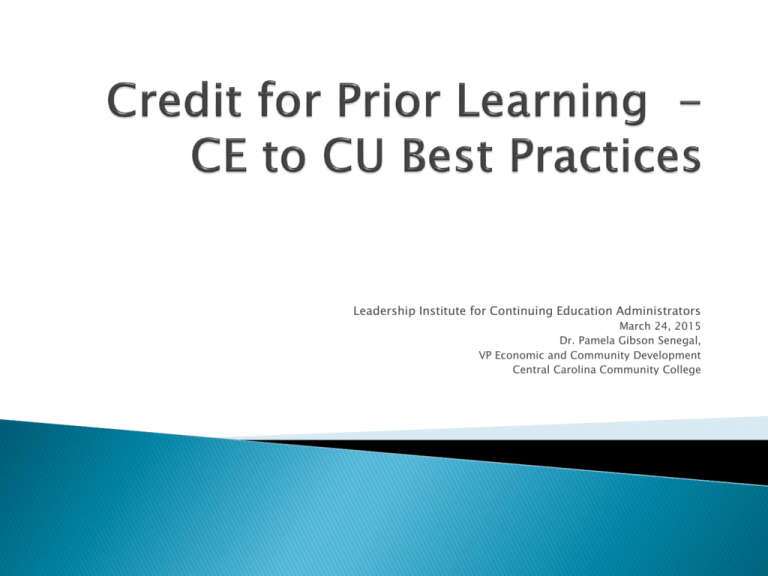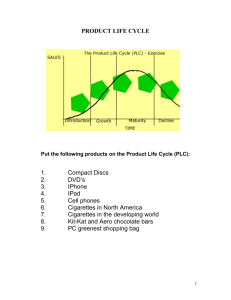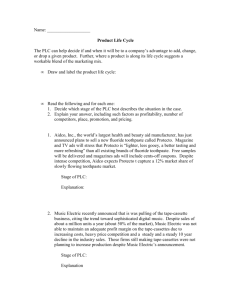Credit for Prior Learning - CE to CU Best Practices
advertisement

Leadership Institute for Continuing Education Administrators March 24, 2015 Dr. Pamela Gibson Senegal, VP Economic and Community Development Central Carolina Community College I. II. III. IV. V. Define what is Prior Learning Credit (PLC). Build a multi-faceted case for doing more with PLC at your institution. Understand the current state of PLC in NC Community Colleges from fall survey results. Identify select resources to assist your institution with starting/furthering PLC. Create an action plan for starting/furthering PLC at your institution post-conference. Military service transcript High School credit High school CT Credit CLEP tests Class attendance certificates Student verbal verification of skill or competency Certifications that are more than 10 years old Language proficiency Travel experiences Certificate of appreciation from volunteer organization Continuing Education classes ESL classes Basic Skills classes College transfer credits MOOCs, online classes AP tests Dante tests Digital Badges Professional development within work settings Conference attendance 3rd party credential earned within 5 years Work experience Completion of military boot camp Webinar attendance Recommendation letters from previous faculty Prior Learning Credit is the result of a RIGOROUS process by which KNOWLEDGE and SKILLS are evaluated for college credit. SACS COC Aficionados Data wonks Compassionate do-gooders Policy and proceduralists Learning first advocates SACS COC Aficionados ◦ “SACS COC will not allow us to do this.” WRONG ◦ Articulation and transfer policies are subject to local institutional decision-making and are largely driven by concerns about what will pass muster with the accreditation agency. The Breaking Through State Policy Initiative, North Carolina Policy Audit, 2011 However, * 3.4.4 – Transfer Credit Institutions must publish policies for evaluation of transfer credit. Documentation is needed, to include: written policies and criteria, and evidence that policies are accessible to students. 3.4.6 – Awarding Credit Institutions must show evidence of a sound academic process for awarding credit – regardless of format or mode of delivery. Documentation is needed, to include written practices for evaluating credit. 3.4.7 – Contractual Agreements Institutions must ensure quality of programs offered and compliance with Principles for all contracting entities. Documentation is needed, to include copies of contracts, and evidence of continual evaluation process. 3.4.8 – Credit for Non-Credit Institution must document equivalency of course work when granting credit for noncredit work. Documentation needed, to include policy statements about process and evidence that policies are published and enforced. * Be aware that independent accrediting organizations may have additional requirements. These are the ones that pertain to SACS COC. Data wonks “The data doesn’t support us making this effort.” WRONG 48 institution study of PLC and related adult student outcomes* with more than 62,000 participants, over a 7 year period, compared students with PLC to those without. Results – PLC increased graduation rates, persistence, and decreases time to degree completion. * Study conducted by CAEL with funding from the Lumina Foundation Data wonks Ask – what would be the economic impact of increasing the number of degree holders in your community? Determine the number of associate degree holders in the counties you serve (www.ncworks.org). Georgetown University’s Center on Education and the Workforce noted that ◦ On average, certificate holders earn 20% more than high-school-educated workers ◦ One-third of certificate holders also have an associate, bachelor’s or master’s degree. In two-thirds of those cases, degree holders earned the certificate first. Compassionate do-gooders “It’s the right thing to do.” RIGHT CAEL/Lumina Foundation Study shows a “PLC effect” Georgetown University’s Center on Education and Workforce did a similar study and found the same effect. ◦ Irrespective of institution type (2 year and 4 year institutions, public and for profits) ◦ Regardless of individual student academic ability or GPA ◦ Regardless of student age, ethnicity/race, or gender ◦ Regardless of whether or not the student receives financial aid ◦ PLC students had better outcomes. ◦ Noted that 80% of today’s college students have commitments other than college. “If you can help today’s working men and women leverage their college-level knowledge and skills toward a certificate or degree, imagine the impact you will make on your community.” Policy and proceduralists “It cannot be done. It is way too complicated.” Consider starting with the PLC policies of a SACS COC community college and then adapting them for your local institution. For example.... Learning first advocates “Faculty have concern that if they didn’t teach it, the students won’t have what they need to succeed.” WRONG - Guiding principles of institutions with significant PLC options are that they are based upon the philosophy that, “recognizes that college-level learning does in fact take place outside of the traditional classroom and in many cases the College may award college-level credit for prior learning based on a RIGOROUS process of evaluation.” Communication/Awareness of Prior Learning Prior Learning Categories Prior Credit Policy and Credit Earned Transcription of Prior Learning Credit What Guidance is Needed? At 86%, colleges are overwhelmingly depending on their website to communicate prior learning options to students. • How many clicks from your home page would a student have to use to find this option? • Is your institution using language to describe this option that students will understand? The second most used options were Word of mouth from faculty/staff, and the Admissions Office both at 74%. • What are the positives/negative s with such high dependence on word of mouth? • What are the positives/negative s of having such high dependence on admissions? Communication/Awareness of Prior Learning ◦ Current methods of communicating the availability of the prior learning credit options are woefully inadequate for students and for internal faculty and staff. ◦ Respondents indicated that message to motivate faculty and staff to do more with PLC, was around being exposed to additional research about the value of PLC. ◦ Resultantly, few NC Community Colleges are awarding consistently significant amounts of PLC. Prior Learning Categories ◦ High school tests – Dual credit, AP, and CTE articulation were the most used. Only dual credit had more than 50 or more awards made in 2013-14. ◦ Life Experience – DSS (formerly known as DANTES) most utilized. Most institutions actually awarded none or fewer than 10 awards in 2013-14. ◦ Third Party Awards – CLEP was the most utilized. Most institutions actually awarded none or fewer than 10 awards in 2013-14. ◦ Local institution based award – Transfer credit from another institution and challenge exams/credit by exam were the most utilized. Transfer credits awarded were more than 50 awards, while challenge exams had none or fewer than 10 awards. Prior Credit Policy and Credit Earned ◦ CE to CU – 60% of institutions had no formal process by which students can receive college credit for completion of specific CE courses. ◦ Military credit – 60% of institutions indicated having a formal process for awarding credit.* ◦ Third party credentials – 65% have no formal process for standard amounts of credit to be awarded for specific credentials. * Standard award for military service is for PED 112, Physical Fitness II, a transfer elective, a one credit hour course. Transcription of Prior Learning Credit Locally based decisions regarding course short title and transcript code have created a hodge podge of transcript content across our system Course Transcript Code Institution 1 APENG Ap English 111/112 Institution 2 APLANG English Language & Composition Institution 3 APENG Institution 4 APENG AP English Language Institution 5 APENG Advanced Placement English What Guidance is Needed? ◦ Standardized recommendations for awarding credit for various types of PLC ◦ Best practices from other institutions ◦ SACS COC compliant processes ◦ Consistency across NC Community Colleges ACE – American Council on Education AICE – Advanced International Certificate of Education CAEL – Council for Adult and Experiential Learning CLEP – College Level Examination Program JST – Joint Services Transcript for military training Learningcounts.org NCCRS – National College Credit Recommendation Service NILOA - National Institute for Learning Outcomes Assessment SOCS – Service members Opportunity Colleges SACS-COC – Southern Association of Colleges and Schools Commission on Colleges Florida has the most aggressive and formalized general statutes on this topic which include an appointed 14 member state Articulation Coordinating Committee, with the specific charge of, “developing guidelines for inter-institutional articulation agreements, examining statewide articulation data, and maintaining student transcript records.” (Higher Education Policies website, 12-13). FLORIDA’s Gold Standard Career Pathways Articulation Agreements of Industry Certification to AAS/AS Degree 2013 Prior Learning Credit Resource Page Framework How to Use this Guidance Document Prior Learning Credit Definitions and Options Accreditation – SACSCOC principles Research and Resources Communication Strategies Implementation and Logistics NC Community College System Office will provide a resource page with links to options that can be the basis for your institution’s local plan. ◦ ◦ ◦ ◦ ◦ ◦ ◦ ◦ ◦ ◦ ◦ Start with high demand occupations Utilize parallel courses Establish career pathways with built in articulations Approach industries with rigorous training programs about articulation Map occupational courses to third party credentials Enlist credit faculty to teach gateway courses Start with two people – an ally and someone with passion Create a cross functional team to develop policies Assess how PLC fits with your institution’s current strategic plan Run a pilot program to build the case for increased outcomes Create a transparent marketing plan Ongoing internal training of frontline staff Training of external workforce partners Updates to website information with non-educational language. Choose at least two of the above options for beginning this work at your local institution. I. II. III. IV. V. Define what is Prior Learning Credit (PLC). Build a multi-faceted case for doing more with PLC at your institution. Understand the current state of PLC in NC Community Colleges from fall survey results. Identify select resources to assist your institution with starting/furthering PLC. Create an action plan for starting/furthering PLC at your institution post-conference. Call Barbara Dr. Pamela G. Senegal 919.718.7254 psene563@cccc.edu






